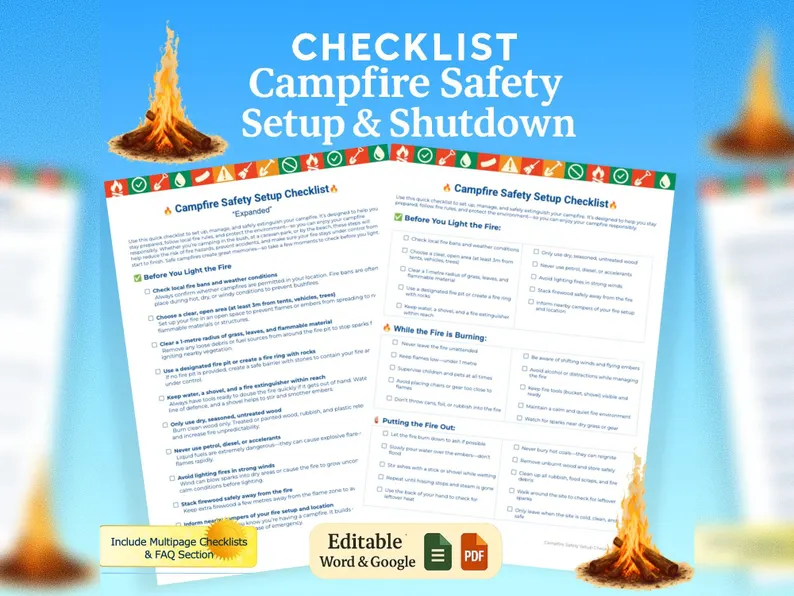Campfire Safety Tips: The Ultimate Guide for Setup, Shutdown & Peace of Mind
Ever found yourself sitting around a glowing campfire, kettle on, kids or mates swapping stories, or just taking a breather after a long day outdoors? Whether you’re on a remote bush trip, at a caravan park, or managing a crew on the fireground, the simple campfire is both comfort and risk. And let’s be honest—one mistake can turn a peaceful evening into a real emergency.
That’s why understanding campfire safety tips—covering everything from setup and shutdown to what to do if things go sideways—is essential for all Australians. This guide is here to walk you through it, step by step, using practical advice, real-life examples, and a few lessons learned the hard way by both campers and firefighters alike. If you want a ready-made step-by-step, try our Complete campfire checklist—a simple tool to help you camp and cook safely, no matter where you are.
What’s Inside This Guide?
- Campfire setup: choosing safe spots and smart methods
- How to light and maintain your fire—without drama
- Shutdown routines for total peace of mind
- Practical tips for families, crews, renters, and remote travellers
- Common mistakes—what firefighters wish everyone knew
- Answers to the most asked questions, from gear to legal rules
How to Prepare: Setting Up Your Campfire the Right Way
Choosing the Right Spot
- Look for bare, level ground—at least 3 metres from tents, trees, bushes, or vehicles.
- Avoid building fires under low-hanging branches or near long grass—those stray sparks are real troublemakers.
- In parks or caravan sites, only use designated fire pits or BBQ areas. If in doubt, ask the site manager or check local rules.
- Check wind direction—don’t let embers blow toward your camp, crew, or bushland.
- Always clear a safety zone around your fire—scrape away leaves, sticks, and grass down to bare earth or rock.
Pack Smart, Plan Ahead
- Bring a sturdy shovel or metal spade, a bucket for water, and a torch or headlamp.
- Carry at least 10 litres of water (per fire)—not just for tea, but for dousing embers fast.
- Gloves, a fire blanket, and a battery-powered radio are smart adds—especially if you’re remote or bush camping.
- Always check local fire danger ratings and total fire bans. See the national fire danger rating system.
- Keep your phone charged, and know the emergency number: 000.
Safe Lighting, Cooking & Fire Management
How to Light Up Safely
- Lay a small base of kindling—twigs or paper—in the centre, with your main fuel (small logs) stacked on top.
- Never use petrol or flammable liquids—use matches, firelighters, or a long-handled lighter.
- Light from the upwind side so flames move through the kindling gently, not with a sudden rush.
- Stay low, keep sleeves rolled up, and have water or sand close by before striking a match.
Cooking, Supervision, and Managing Risks
If you’re cooking, set pans or grills firmly—never balance on uneven stones or branches. Keep all flammable gear (like paper towels, sprays, or fuel bottles) away from flames.
Don’t walk off “just for a minute.” Fires left unattended—even small ones—can escape with one gust of wind. On the fireground, crews always leave a “watcher” with every fire, even during meal breaks or shift changes.
Shutdown: How to Leave No Trace and Sleep Easy
Putting Out Your Campfire—Properly
- Let the fire burn down to white ash if you can. Don’t rush it—embers hold heat longer than you think.
- Pour water slowly and evenly over every part—listen for sizzling. Don’t just splash and dash.
- Stir the ashes with a stick or shovel. Add more water, and stir again. Keep going until there’s zero heat—check with the back of your hand (not fingers).
- Scatter the cool, wet ash over a wide area if you’re leaving the site, but never bury hot coals—they can smoulder for hours.
- Double-check: No steam, no smell, no warmth? Only then pack up and leave.
Common Shutdown Mistakes
- Burying coals instead of flooding them—they can reignite long after you leave.
- Leaving without checking every ember, especially after midnight or before a move.
- Assuming rain will finish the job—it won’t. Water, stir, check. Repeat if needed.
- Not supervising kids or pets during shutdown. Excited or tired kids can stir up coals or wander into danger zones.
Packing, Planning & Practical Lessons
Packing Essentials for Every Fire
For Families & Campers:
- Fire blanket, gloves, shovel, spare torch
- Dedicated water (10L+)
- Spare matches/lighter (kept dry)
- First aid kit—always
For Renters & Urban Areas:
- Portable BBQ tools (if fire not allowed)
- Fire extinguisher (multi-purpose)
- Battery-powered radio
- Neighbours’ phone numbers
For Fire Crews & Volunteers:
- Gear checks—ensure all firefighting tools and PPE are serviceable
- Account for water points and egress routes
- Nominate a fire safety observer
- Radio set to local emergency channel
Real Stories & Little-Known Tips
You’d be surprised how often “just one spark” is all it takes for things to go wrong. I’ve seen seasoned campers forget to pack water for shutdown and end up shovelling sand for twenty minutes, or crews on a late shift forced to hunt for a safe place to set a meal fire. Sometimes it’s the little things—like leaving gloves on a wet log or kids wandering too close at pack-up—that catch you out.
- If in doubt, don’t light up. If the wind’s up or you’re tired, make a cuppa another way.
- Let your group know the shutdown time before you start cooking—less rushing, more safety.
- Review your plan together, especially if camping with new people, kids, or pets.
- Ask for a “last check” buddy—someone who circles the site for leftover embers or gear.
Campfire Safety Mistakes & How to Avoid Them
The Most Common Pitfalls (and How to Stay Safer)
- Lighting fires during total fire bans or in unsafe conditions. Always check local restrictions.
- Building oversized fires “for warmth”—smaller fires are easier to control and put out.
- Leaving campfires unattended or not fully out, even for a few minutes.
- Underestimating wind or dry grass nearby—sparks can travel far and fast.
- Not having water, sand, or a fire extinguisher ready at all times.
- Rushing shutdown after a long night—tired minds miss hot embers.
- Letting kids or pets play near the fire after cooking or when packing up.
Support, Learning, and Your Safety Community
You’re Not Alone—Build Safe Habits Together
Campfire safety isn’t just about your camp or crew—it’s about the people, wildlife, and land around you. Ask your neighbours or park rangers for local advice, and help new campers learn the ropes. If you’re part of a fire brigade, share practical tips at training nights, not just the big “war stories.”
Share what you learn—pass on checklists, talk over plans with family or friends, and encourage safe routines every time. For more on bushfire preparedness, see our How to Prepare for a Bushfire guide or download a printable emergency plan template.
Frequently Asked Questions
Q: Are campfires banned everywhere during summer?
Q: What’s the safest way to put out a campfire?
Q: Can I use old logs or building wood as firewood?
Q: I’m a new volunteer firefighter—any tips for campfire patrols?
Q: What about pets or young kids near the fire?
Safe campfires are everyone’s business. Take five minutes now to chat through your shutdown routine with your group or family. Share this guide, download a Complete campfire checklist, and help keep your next trip safe and stress-free.



